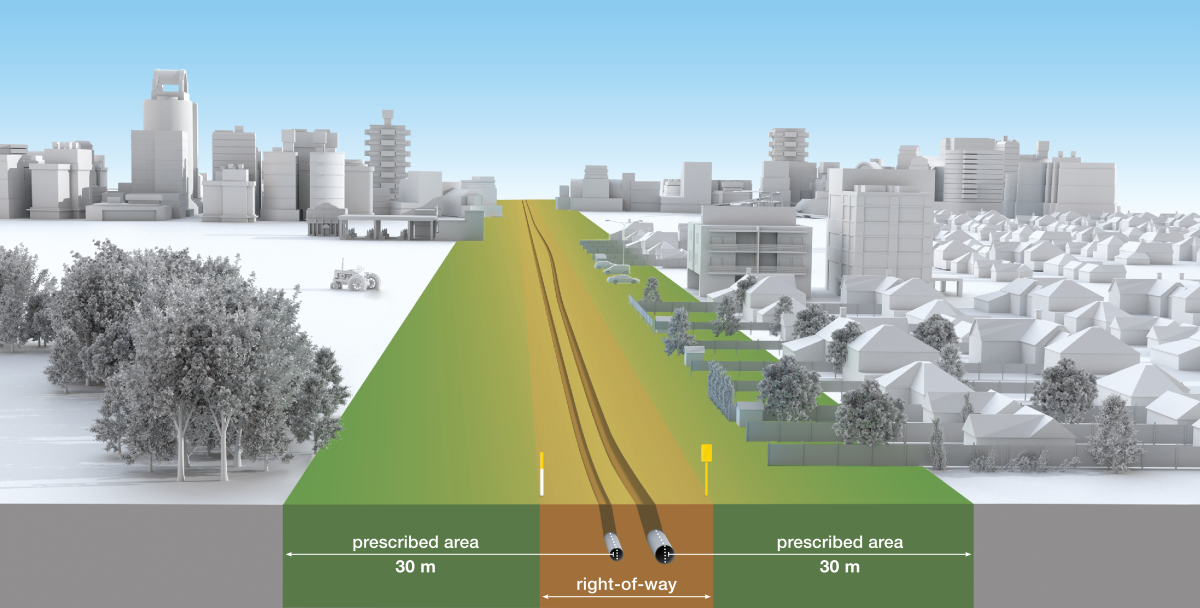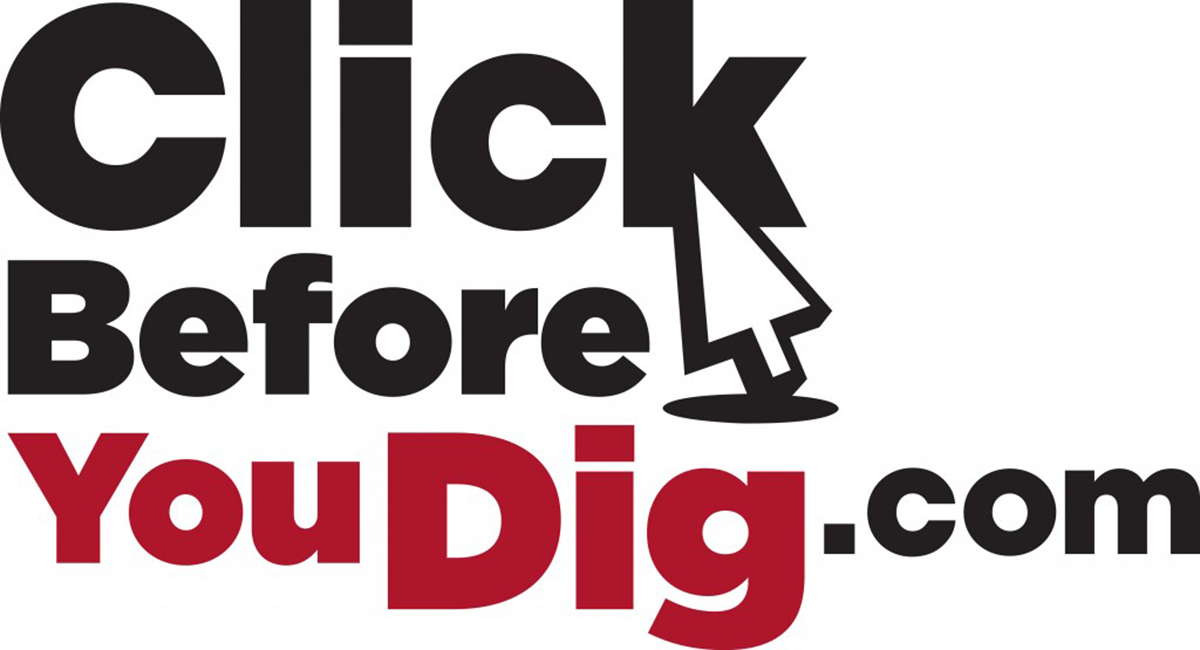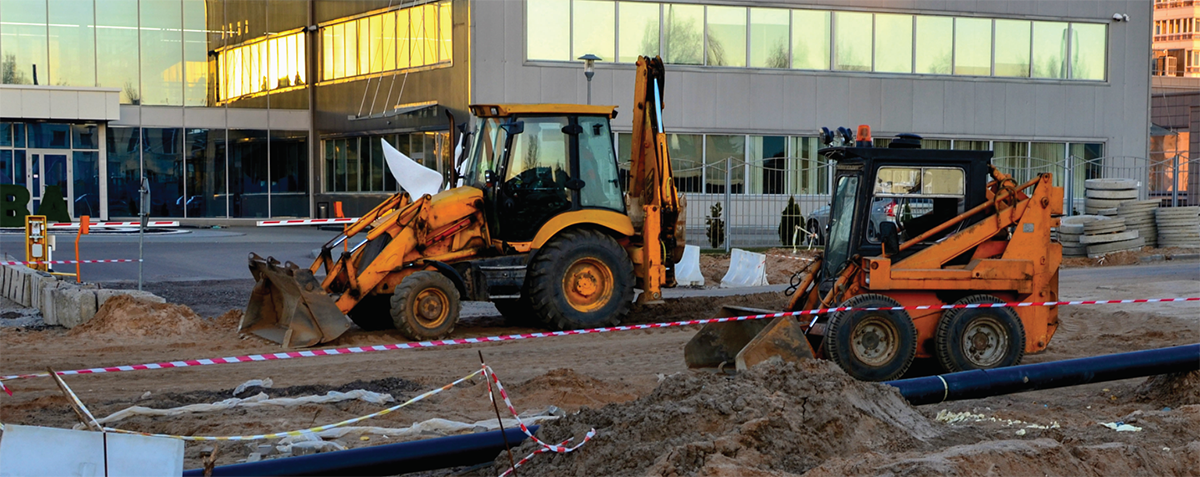Construction Near Pipelines
Construction Near Pipelines [PDF 7667 KB]
Copyright/Permission to Reproduce
Table of Contents
- Who is this information for?
- Where do the pipeline damage prevention regulations apply?
- Activities and equipment
- What is a ground disturbance?
- Pipeline information that affects your work
- Driving across a pipeline
- Constructing a facility
- How to make changes to plans after you get consent
- Your duty to inform others
- Agreeing to activities and costs
- If you don’t follow the regulations
- Your duty to inform others

The Canada Energy Regulator (CER) works to keep energy moving safely across the country. We regulate pipelines that cross provincial, territorial or national boundaries or that are longer than 40 km, while enforcing some of the strictest safety standards in the world.
In this publication, we explain how to work in the prescribed area, the zone where safety precautions are required for work near CER- regulated pipelines (including the right-of-way), crossing a pipeline with vehicles or mobile equipment and building facilities on or near a pipeline.

Who is this information for?




Damage prevention is a shared responsibility, and we all have a role to play. This information is for, but not limited to, the following groups doing any work near federally regulated pipelines:
Contractors
- companies
- contractors, sub-contractors
- project owners
- developers
- farmers, producers, ranchers
- people living near a pipeline
- public
Government Agencies
- municipalities
- counties
- Indigenous governing bodies
- ministries responsible for hiring contractors or have oversight of those who do
- any other local, provincial, or federal agencies
Regulatory reference
This document refers to the following regulations:
- Canadian Energy Regulator Act (CER Act, section 335) (available on the Justice Laws, Government of Canada site)
- Pipeline Damage Prevention Regulations – Authorizations (DPR–A)
- Pipeline Damage Prevention Regulations – Obligations of Pipeline Companies (DPR–O) (available on the Justice Laws, Government of Canada site)
Where do the pipeline damage prevention regulations apply?
The prescribed area – the zone where safety precautions are required for work near CER- regulated pipelines
The prescribed area, sometimes called the safety zone, is a strip of land measuring 30 m extending out perpendicularly in both directions from the centreline of the pipe. If there is more than one pipeline in the right-of-way (ROW), the prescribed area is measured from the outermost pipelines on each side.
For more details, see DPR–A section 2.
Working in the prescribed area
In the prescribed area, you must take extra precautions and get written consent from the pipeline company (or receive an Order issued by the CER Commission) before you can do certain activities.

Activities and equipment in the prescribed area are regulated for safety and to prevent contact with and damage to the pipe. You must have written consent from the pipeline company for:
- any project that digs 30 cm or deeper within the prescribed area
- any cultivation that is 45 cm or deeper within the prescribed area
For examples, see activities and equipment.
The pipeline company must make sure your activities won’t damage the pipe before it gives consent. If the pipeline company gives consent, it must also give you written information to explain how to do your activities safely. You need this information not just for your safety but also for the safety of the public and the environment.
Know what’s below
In addition to federally regulated pipelines, there may be other provincially and locally regulated pipelines and cables in your area. These facilities may include oil and gas field gathering pipes, gas distribution systems, fibre optic cables, water and sewer lines, and electrical cables.
Before you start your activities, contact Click Before You Dig.
Right-of-way

The right-of-way is the strip of land for which a company has obtained the right to construct and operate a pipeline. The width of the right-of-way varies according to size, routing, and number of pipelines. The area of the ROW is within the prescribed area, and is usually smaller than the prescribed area. You need to get the pipeline company’s written consent before you dig or build anything, such as a fence, a deck, outbuilding or even a playhouse on a pipeline ROW.
The prescribed area is measured 30 m outwards from the centreline of the pipe and is present whether or not there is a right-of-way.

Activities and equipment
There are some activities and equipment types that the pipeline company needs to know about before you start your project to make sure that you, the public, and the pipe are protected.
Activities in the prescribed area that require consent from the pipeline company:
- disturbing the ground 30 cm or deeper
- cultivation that is 45 cm or deeper
Examples of these activities can include, but are not limited to:
- digging, excavating
- trenching, ditching
- underground facility maintenance (water, sewage, electrical, gas, oil, etc.)
- development projects
- building fences, driving posts, augering
- digging / maintaining dykes, ditches, culverts
- building structures (retaining wall, shed, garage, fence, pool, etc.)
- building driveway, private road, lane, parking lot
- boring, drilling, pushing, horizontal directional drilling, tunneling
- land levelling, grading, road projects
- landscaping
- sodding, topsoil stripping
- installing / maintaining overhead power or telecommunication line
- installing utility poles, driving bars, rods, pins, anchors or pilings
- clearing land, felling trees, stump removal
- drainage projects, installing irritation system
- ploughed-in cable
- planting or removing trees
- quarrying
- snow removal
- large mowers
Contact Click Before You Dig before you start your activities, and follow the 7 steps to working safely near pipelines.
DPR–A section 7 and section 10 relate to the activities above.
Certain activities are prohibited. Learn about them in the CER Act, section 335(1).

Important note on mechanical excavation:
You must NOT mechanically excavate within 3 m of the pipe, unless you follow the measures in the Damage Prevention Regulations.
For more details, see DPR–A Section 10.
Equipment
You need consent from the pipeline company to drive certain equipment on, along, or across the pipeline right-of-way. You also require consent if you plan to dig 30 cm or deeper in the right-of-way and/or prescribed area.






Equipment requiring consent includes, but is not limited to:
- excavator / backhoe / trackhoe
- auger
- bulldozer
- front end loader
- grader
- trencher / ditcher
- skid steer / bobcat
- crane
- dump / haul truck
- power shovel
For more details, see Driving across a pipeline
Read about prohibited operation of vehicles and mobile equipment in the CER Act, section 335(2).
What is a ground disturbance?



Broadly, a ground disturbance is any activity that moves or penetrates the ground. In the CER Act, ground disturbance is more specifically any activity within the prescribed area that involves any of the following:
- the soil being disturbed or displaced to a depth of 30 cm (12 in) or deeper
- agricultural cultivation to a depth of 45 cm (18 in) or deeper below the surface of the ground
- activity resulting in a reduction of soil cover provided over the pipeline to a depth that is less than the cover provided when the pipeline was constructedFootnote 1
For more details, see DPR–A Section 10.
Read about prohibited operation of vehicles and mobile equipment in the Canadian Energy Regulator Act (CER Act), section 335 (2).
Pipeline safety information that affects your work
Depth of cover
How deep is the pipe? Depth of cover is the depth of the soil measured from the top of the pipeline to the ground surface. The depth varies for each pipeline, depending on ground conditions and when the pipeline was first constructed. Depth of cover can change over time with compaction, activities, soil removal, ground settling, wind erosion and flooding, etc. Other pipes and cables may be installed at shallower depths than federally regulated pipelines. The CER Pipeline Damage Prevention Regulations restrict excavation such as digging or augering 30 cm or deeper in the prescribed area to protect you, the pipe, and the environment.
For more details, see DPR–A Section 10.
Pipeline signs

The pipe can be placed anywhere within the ROW and are often not in a straight line or always at the same depth. Pipeline signs (or markers) are placed at locations along the pipeline route and where roadways and waterways intersect with pipelines. The signs indicate that there are pipelines in the area but do not show the exact location of the pipeline. They may contain the name of the company, the product, the size of pipe, and pipeline emergency contact numbers, as well as the reminder to contact a One-Call Centre before conducting work or crossing the pipeline with a vehicle or mobile equipment.

When you request consent from a pipeline company, it must, within 10 working days after receiving the request, inform the person that made the request whether the consent has been granted or refused and, in the case of a refusal, the reasons for the refusal.
Pipeline locates
You must have the pipeline located and marked by the company before you start your activities. To do this:
- Contact the pipeline company to get consent
- Once consent is received, contact the One-Call Centre at least 3 working days before you start.
If your work involves a ground disturbance, you are responsible for making the locate request. You must have all buried pipelines and cables identified and have their location marked before you start.

Don’t just start digging or building.
It takes time to locate pipes and cables and to get consent.
The person doing the ground disturbance work is responsible for making the locate request. This request ensures that all buried facilities are identified and their location marked before you start.
The pipeline company’s locator will come to the site with locate equipment. The locator will mark the pipe location on the ground with paint, temporary stakes or pin flags. You may be required to meet the locator at the site so that they can explain the meaning of the markings and give you information or instructions that may be necessary to work near the pipeline safely.
Federally regulated pipeline companies locate and mark their pipes at no cost to you. It’s free, and it’s the law.
For more details, see DPR–A Section 3.
Locate mark legend
The colours used to temporarily mark the horizontal alignment of underground facilities should be consistent with the American Public Works Association Uniform Colour Code:
| WHITE |  |
proposed excavation |
| PINK |  |
temporary survey markings |
| RED |  |
electrical, lighting cables |
| YELLOW |  |
gas, oil, steam |
| ORANGE |  |
telephone, cable, TV, signals, alarms |
| BLUE |  |
potable water |
| GREEN |  |
sanitary and storm sewer, culverts |
| PURPLE |  |
reclaimed water, irrigation, slurry |
Contact with the pipe

It is imperative to avoid contact with the pipe. Even a small nick in the pipe’s coating can cause corrosion and become a hazard to the safety of the pipe, to you, to the public nearby, and to the environment if you cause a release. Corrosion may cause damage that can result in a release of product immediately or years later. Inform the pipeline company immediately if any equipment contacts the pipe or its coating.
Backfilling

You must give a pipeline company 24 hours’ notice before excavating or running a project near a pipeline. The pipeline company may require that an authorized representative be on site or provide specific instructions about how to backfill over the pipe.
For more details, see DPR–A Section 10.
7 steps to working safely near pipelines
- Check:
- pipeline signs for phone numbers, and contact the pipeline company
- land records for easements
- CER Damage Prevention Regulations – Authorizations
- For any ground disturbance in the prescribed area that will go 30 cm or deeper, get written consent from the pipeline company.
- Contact the One-Call centre (Click Before You Dig) to start the locate process, and obtain the required safety information from the pipeline company following a locate request.
- Be on site when the company technician arrives.
- Wait until the pipeline company representative is on site before starting, as per their instructions.
- Have the One-Call ticket and written consent from the pipeline company on site.
- Inform the pipeline company immediately if any equipment contacts the pipe.

Click to enlarge [PDF 1137 KB]
Description
Activities that do not require consent
- digging less than 30 cm below the surface (for example: planting flowers)
- agricultural cultivation less than 45 cm, unless notified by the pipeline company that it’s unsafe to do so in certain areas
Activities that require consent
- driving vehicles or mobile equipment on the right-of-way (does not include agricultural activities)
- placing a structure on a right-of-way (for example: fence, pool, wood pile)
- removing earth cover from the right-of-way
- agricultural cultivation 45 cm or deeper in the prescribed area
- ground disturbance 30 cm or more in the prescribed area (for example: digging holes for fence posts or deck footings)
Driving across a pipeline



Operating a vehicle or mobile equipment across a pipeline, including over the right-of-way, is prohibited unless:
- there is consent from the pipeline company (or an Order from the Commission)
- it is within the travelled portion of a highway or public road
Moving vehicles or mobile equipment over a pipeline can increase the stresses on the pipe and cause rutting, which could damage the pipe. Driving with narrow tires or old equipment, especially in damp conditions, may cause ruts. These can reduce cover over the pipe, and tires may damage pipe coating.
The factors that must be considered include: depth of cover above the pipe; soil type; ground conditions; pipe composition; creation of pressures on the pipe by static and dynamic loads, and operating stresses experienced by the pipe. This information can only come from the pipeline company.
The pipeline company may use the following factors to determine if the equipment can be used on the right-of-way:
- gross vehicle weight rating (GVW)
- vehicle class
- number of axles
- load
- tire pressure or ground pressure
- size
The pipeline company will advise on vehicle management and if or where vehicles and equipment can cross safely. The pipeline company does this to prevent damage to both the soil and the pipeline. Review where you can cross with vehicles with your staff and subcontractors regularly.
You must get written consent from the pipeline company to park vehicles on the ROW.
DPR–A Sections 12 refers to the activities above.
Read about damage prevention in the CER Act, section 335 (2).

Ruts 30 cm or deeper in the prescribed area are a ground disturbance.
Contact the pipeline company if soil conditions pose a risk of ruts caused by vehicles or mobile equipment.
Constructing a facility
You must comply with the CER Act and DPR – Authorizations to construct or place a facility across, on, along, or under a pipeline. Before you construct a facility, you must do the following:
- Get the pipeline company’s written consent
- Make a locate request
- Follow safety information from the pipeline company

Examples of facilities can include, but are not limited to:
- a structure (anything built or installed), for example: a fence, concrete conduit structure, retaining wall, outbuildings, house, shed, gazebo, wood pile, swimming pool
- vehicles parked on the ROW (cars, boats, trailers, RVs and buses)
- a highway, driveway, private road, lane, parking lot, walkway
- a railway
- a drainage or irrigation system, including dykes, ditches and culverts
- a berm
- a telecommunication line or power line
- a pipe, for example: a water main, sewer, gas line, oil line
Read DPR–A section 7 and section 10 for more information.
Read about prohibited construction and ground disturbances in the CER Act, section 335 (1).
Overhead lines
Before you construct an overhead line across a pipeline, you must first make a locate request. The next step is to get a copy of the pipeline company’s safety practices and permitting procedures. These will provide you with the information needed to work safely near the pipeline. You will also need confirmation that all pipes in the construction area have been marked. You must not construct or place poles, pylons, towers, guys, anchors, or supporting structures across, on, along or under pipelines, which includes the ROW.
If the pipeline is patrolled by air, aerial warning devices on the overhead line must be installed and maintained to not pose a risk to aircraft patrolling pipelines.
Maintaining an existing facility



Owners of facilities near a federally regulated pipeline must maintain their facilities in good condition. Maintenance work on these facilities that disturbs the ground less than 30 cm in the prescribed area is authorized.
Maintenance activities that may be authorized can include:
- adjusting valves, valve boxes, manholes
- sidewalk panel replacement, curb removal
- saw cut less than 30 cm deep
- road milling and patching less than 30 cm deep (large or small project)
- planting less than 30 cm deep, depending on the vegetation allowed
- signposts less than 30 cm deep
If you need to disturb the ground 30 cm or deeper near a federally regulated facility, you must contact the One-Call Centre to open a ticket for your work. They will send a notification to companies in the area that you have requested a ticket to work near their lines and CER regulated pipeline companies will come out and do a locate for free.
Follow the 7 steps to working safely near pipelines.
Find full details in Damage Prevention Guidance for Municipal Operations and Maintenance Activities on the CER website.
Read more on DPR–A Section 8.

How to make changes to plans after you get consent
If the work area of your project gets bigger, or moves, that is called scope change. Scope changes can include changes to design, location, or type of facilities or structures to be built. To make sure that the changes don’t impact safety and that your project follows the requirements in the regulations, you must contact the pipeline company before you start.
Read DPR–A sections 8, 10, and 11 for more information.

Bid requests and contracts should include the fact that there’s a federally regulated pipeline in the work area and all work must be done in accordance with the DPR – Authorizations.
Your duty to inform others
If you hire or contract someone to do work near a pipeline, you must inform everyone working on your behalf of these regulations before the project starts.
Project owners or landowners hiring contractors have to tell them that there is a pipeline on the land and the requirements under the DPR – Authorizations, including the requirement to contact the One-Call Centre.
The person doing the work on the construction or a ground disturbance activity is responsible for ensuring:
- the locate request has been made
- they have all of the information from the pipeline company to do the work safely
For more details, see DPR–A section 4.
Agreeing to activities and costs


Get help from the CER to reach agreements
If you and the pipeline company cannot reach an agreement, the CER can help. Options include:
- Using Alternative Dispute Resolution to negotiate an agreement.
- Filing a section 335 application to address:
- ground disturbance and associated cost apportionment;
- facility construction and associated cost apportionment;
- vehicle or mobile equipment crossings near federally regulated pipelines.

For more information and to get started, visit the CER website and look up:
- Guiding Principles for Cost Apportionment
- Section 335 Applications – Process Guidance for Applicants
If you don’t follow the regulations
Damage Prevention Regulations exist for the safety of people, the environment, and property. Following the regulations allows your projects to proceed safely. CER regulated pipeline companies must report all violations of the DPRs and any damage to the pipe and its coating for the CER to track and potentially follow up.
The coating on a pipe is the first defense against corrosion. If you contact the pipe, the coating may be damaged and could eventually cause a rupture. Damage to the pipe or its coating, regardless of whether there was a release of product or not, must be reported to the pipeline company.
Violating regulations can lead to CER enforcement, fines, and penalties. If a person or company does not comply with regulations, the CER may use a variety of tools to ensure compliance and keep non-compliances from being repeated. A contravention of the Canadian Energy Regulator Act or Damage Prevention Regulations can be subject to a monetary penalty under the Administrative Monetary Penalties Act.
Administrative Monetary Penalties
Maximum daily penalties:
For individuals:

$25,000 per violation
For companies:

$100,000 per violation
Each day a violation continues is considered a separate violation. This means that separate penalties could be issued per infraction, per day, with no maximum total fine.
For more information, visit the CER site and look up Administrative Monetary Penalties.
For information on what the pipeline companies must do, see Damage Prevention Regulations – Obligations
For more information on damage prevention regulations, see Damage prevention.
Find out more
Find out more about the Canada Energy Regulator
by visiting us online.
Be sure to follow us on social media for the latest updates.
For copies of any CER publication or for more information, contact us:
ONLINE: www.cer-rec.gc.ca
EMAIL: publications@cer-rec.gc.ca
TOLL FREE: 1-800-899-1265
Write us or visit our library at:
Canada Energy Regulator
210-517 10 Ave SW
Calgary AB T2R 0A8
- Date modified:
